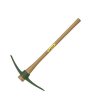Why did NAB stock get flogged today after such a positive final year report? Don't get it?
Result was weak underlying. Driven more by a reduction on doubtful debts. Net interest margin fell. UK not being sold quickly. Dividend not above expectations. Take your pick.








